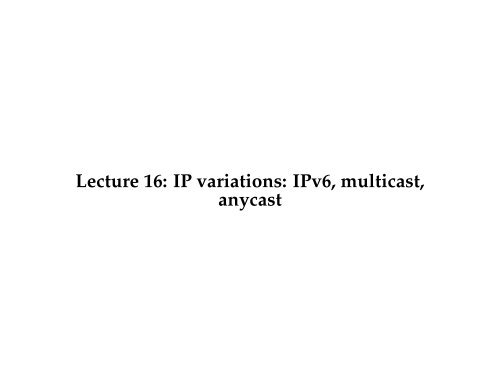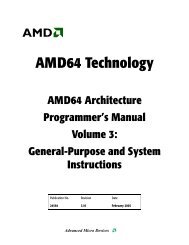Multicast and IPv6 - Stanford Secure Computer Systems Group
Multicast and IPv6 - Stanford Secure Computer Systems Group
Multicast and IPv6 - Stanford Secure Computer Systems Group
Create successful ePaper yourself
Turn your PDF publications into a flip-book with our unique Google optimized e-Paper software.
Overview• Next generation IP: <strong>IPv6</strong>• 6lowpan <strong>and</strong> the Internet of Things• IP multicast• IP anycast• Practical considerations throughout
I think we have a problem- Projected use of /8 blocks- From “A Pragmatic Report on IPv4 Address SpaceConsumption,” Tony Main, Cisco <strong>Systems</strong>.
<strong>IPv6</strong>• Work started in 1994• Basic protocol published in 1998 (RFC 2460)• Brief lull, the progress in 2003-6• Hard push within IETF today for adoption
• 128 bit addresses- Autoconfiguration<strong>IPv6</strong> Key Features• Simplifies basic packet format through extensionheaders- 40 byte “base” header- Make uncommonly used fields optional• Security <strong>and</strong> authentication
<strong>IPv6</strong> HeaderVer Class FlowLength Next Hdr. Hop limitSource(16 octets, 128 bits)Destination(16 octets, 128 bits)
<strong>IPv6</strong> Header Fields• Version, 4 bits: 6 for <strong>IPv6</strong>• Class: 8 bits: like TOSS in IPv4• Flow, 20 bits: identifies a flow• Length, 16 bits: datagram length• Next header, 8 bits: more later• Hop limit, 8 bits: like TTL in IPv4• Addresses: 128 bits
<strong>IPv6</strong> Addresses• Simplify DHCP <strong>and</strong> autoconfiguration• Break 128 bits into 80-bit network <strong>and</strong> 48-bitinterface- Many link layers have unique interface addresses (more onthis later in quarter)- E.g., Ethernet is 48 bits- Use of 48-bit ID ensures no address collisions, makes DHCPstateless
v4 Interoperability• RFC 4291• Every IPv4 address has an associated <strong>IPv6</strong> address• Simply prefix 32-bit IPv4 address with 96 bits of 00000 x 12IPv4 address
v4 Interoperability, continued• Two <strong>IPv6</strong> endpoints must both have <strong>IPv6</strong> stacks• What about transit network?• v6 - v6 - v6 (no problem)• v4 - v4 - v4 (no problem)• v4 - v6 - v4 (no problem)• v6 - v4 - v6 (uh-oh)
6-4-6 ExampleAD 1IPv4D 26 4 4 6B
IP Tunneling• Encapsulate an IP packet inside another IP packet• Makes an end-to-end path look like a single IP hopIPv4 Header<strong>IPv6</strong> Packet<strong>IPv6</strong> Packet
6-4-6 Example, RevisitedAD 1IPv4D 26 4 4 6B
Other Tunneling Use: VPN• Virtual Private Networks• Use case: two distance corporate offices- Want to access each other’s internal networks- Make it looks like they’re the actually one network• Set up an encrypted TCP stream between one hostat each network• Route packets to other office through this host• If addresses are all private, network is private
Extension Headers• Two types: destination <strong>and</strong> hop-by-hop• Both have a next header byte• Destination headers: intended for IP endpoint- Fragment header- Routing header (loose source routing)• Hop-by-hop headers: processed by each node- Jumbogram: packet is up to 2 32 bytes long
Example Next Header Values• 0: Hop-by-hop header• 1: ICMPv4• 4: IPv4• 6: TCP• 17: UDP• 41: <strong>IPv6</strong>• 43: Routing header• 44: Fragmentation header• 58: ICMPv6
MTU Requirement• IPv4 requires a 576-byte link MTU• <strong>IPv6</strong> requires 1280-byte MTU• If link MTU is smaller, then it MUST supportsub-IP fragmentation <strong>and</strong> assembly to provide a1280-byte MTU• It SHOULD provide a 1500-byte MTU; nodesMUST receive 1500 byte packets
Fragmentation Revisited• High-loss links (e.g., wireless) can be a problem• 10-hop route, each link has a 10% drop rate (90%success rate)- Probability one fragment arrives is 0.9 10 ≈ 35%- Each fragment is transmitted1 + 0.9 + 0.9 2 + 0.9 3 ...0.9 9 ≈ 6.5 times along the route- 100% chance on first hop, 90% on second hop, 81% on thirdhop, etc.
Fragmentation Revisited, Continued• If a packet has four fragments, deliveryprobability is 0.35 4 ≈ 1.4%• Total transmissions/delivery = 10.014 · ∑9i=0 0.9 i• Total transmissions/delivery = 65 · 6.5 = 423• Fragmentation header in <strong>IPv6</strong> is a destinationheader- Fragmentation is possible, but must be done at the source
Link-layer reliability• High-loss link layers usually have single-hop acks<strong>and</strong> retransmissions- End-to-end argument: when can layer 2 reliability failend-to-end?• 10-hop route, each link has a 10% drop rate- Expect10.9≈ 1.1 transmissions/link- 10 links, 11 transmissions- 44 transmissions/delivery
Practical Considerations• <strong>IPv6</strong> is only partially deployed• No “killer app”• It’s really expensive to replace everything!• No switch day: IPv4 will always live on• Multihoming <strong>and</strong> address fragmentation iscausing routing tables to grow very large- <strong>IPv6</strong> will make this much, much worse...
IPv4 Status
RIRs
Flaw in the Argument• Original <strong>IPv6</strong> motivation was “IPv4 addresses willrun out”• Addresses are a resource; they have a value (youdon’t run out of l<strong>and</strong>)• NATs allow multiple nodes to share an IPv4address• <strong>IPv6</strong> will become the default when IPv4 addressesare so expensive that it’s cheaper to deploy <strong>IPv6</strong>• IETF T-shirt: 32 + 16 > 128
A Market in Addresses• A market won’t solve the problem, though• IPv4 addresses can’t be legally owned in someregions• Trading will further fragment the address space
6lowpan <strong>and</strong> the Internet of Things
Internet of Things• Increasing connectivity: wireless controllers, lightswitches, etc.• Home area networks, personal area networks• Today: vertically integrated, separate technologies• Goal: connect them with IP• Imagine every light has an IP address...
6lowpan• IETF working group on <strong>IPv6</strong> for low-powerpersonal area networks (PANs)• Tiny, energy constrained, wireless devices: smarthomes, ubiquitous computing• Link layers have tiny MTUs: (802.15.4 is 127 bytes)• RFC 4944
6lowpan Header Compression• 6lowpan tries to compress common cases: TCP,UDP, etc.• Example: address compression- 6lowpan must allow full 128-bit addresses- Address fields alone are 32 bytes!- But often they can be shortened...
6lowpan Header Compression• draft-ietf-6lowpan-hc-13 (updates RFC 4944)0 1 2 3 4 5 6 7 8 9 0 1 2 3 4 5+---+---+---+---+---+---+---+---+---+---+---+---+---+---+---+---+| 0 | 1 | 1 | TF |NH | HLIM |CID|SAC| SAM | M |DAC| DAM |+---+---+---+---+---+---+---+---+---+---+---+---+---+---+---+---+
6lowpan Compression Flags• SAC: Source address (stateful?)• DAC: Destination address (stateful?)• SAM/DAM: compression scheme used, forstateless:- 00: Full 128 bit address- 01: 64-bit address, other 64 are link-local prefix paddedwith zeros- 10: 16-bit address, other 112 are as above- 00: 0-bit address, 64-bit link local prefix + 64-bit link layeraddress
2-minute stretch
<strong>Multicast</strong>• Problem: want to send a packet to many nodes- Examples: IP-TV, large audio stream• Using n unicast packets means the same packetcan traverse a single link many timessrc Internet gw aaaaa
<strong>Multicast</strong> Approach• Nodes can join a multicast group• Denoted by a multicast IP address• Routers build a routing topology- Link state vs. distance vector• IGMP: Internet <strong>Group</strong> Management Protocol- Protocol for hosts to manage membership in multicastgroups- Hosts talk to local multicast routers
Example: Link State Tree• Routers exchange link state• Node advertise presence in group• Routers compute shortest-path multicast tree• Very expensive!
Network TopologyBAR1R2R3R4R5CR6R7
Tree for A as <strong>Multicast</strong> SourceBAR1R2R3R4R5CR6R7
Tree for B as <strong>Multicast</strong> SourceBAR1R2R3R4R5CR6R7
Practical considerations• <strong>Multicast</strong> protocols end up being very complex• Introduce a lot of router state• Turned off on most routers• Used within a domain, not between domains• How does one h<strong>and</strong>le congestion control?
IP Anycast
Anycast• Communicate with “any” one of a set of nodes• We’ve seen this with DNS\$ dig www.google.com...;; ANSWER SECTION:www.google.com. 604799 IN CNAME www.l.google.com.www.l.google.com. 300 IN A 74.125.19.103www.l.google.com. 300 IN A 74.125.19.104www.l.google.com. 300 IN A 74.125.19.147www.l.google.com. 300 IN A 74.125.19.99
Anycast at IP layer• DNS allows anycast through name → addressmappings• Sometimes we need it at layer 3 itself- Single IP address refers to multiple hosts- Need to talk to any one of them• Example: DNS root servers- Would like to scale number of root servers with Internet- Can’t use DNS (remember root servers hard-coded)- Want to query closest root server
Anycast in Forwarding Tablse• Remember, forwarding is longest-prefix-match• An anycast address is a /32 address• A single router may have multiple entries for theaddress• Anycast best used in services where separatepackets might go to different destinations
• A /32 routing entry!The Cost• Multiple /32 routing entries!
• Geographic scopingFurther Advantages• Distributed Denial of Service (DDoS)- Since anycast is at IP layer, load from DDoS is distributedacross many anycast nodes• F root server made anycast in 2002, now 12locations
Overview• Next generation IP: <strong>IPv6</strong>• 6lowpan <strong>and</strong> the Internet of Things• IP multicast• IP anycast• Practical considerations throughout
















